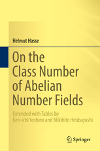- About MAA
- Membership
- MAA Publications
- Periodicals
- Blogs
- MAA Book Series
- MAA Press (an imprint of the AMS)
- MAA Notes
- MAA Reviews
- Mathematical Communication
- Information for Libraries
- Author Resources
- Advertise with MAA
- Meetings
- Competitions
- Programs
- Communities
- MAA Sections
- SIGMAA
- MAA Connect
- Students
- MAA Awards
- Awards Booklets
- Writing Awards
- Teaching Awards
- Service Awards
- Research Awards
- Lecture Awards
- Putnam Competition Individual and Team Winners
- D. E. Shaw Group AMC 8 Awards & Certificates
- Maryam Mirzakhani AMC 10 A Awards & Certificates
- Two Sigma AMC 10 B Awards & Certificates
- Jane Street AMC 12 A Awards & Certificates
- Akamai AMC 12 B Awards & Certificates
- High School Teachers
- News
You are here
On the Class Number of Abelian Number Fields

Publisher:
Springer
Publication Date:
2019
Number of Pages:
365
Format:
Hardcover
Price:
109.99
ISBN:
978-3-030-01510-7
Category:
Monograph
[Reviewed by , on ]
Fernando Q. Gouvea
06/17/2019
When this book was written in the early 1950s, the basic theorems of class field theory had been known for at least 20 years, longer if one includes the period when these results were conjectured but only partially proved. Class field theory gives a description of the arithmetic of all extensions \(F\) of a number field \(K\) such that the Galois group \(\mathrm{Gal}(F/K)\) is abelian. When \(K=\mathbb Q\), this description includes the fact that all abelian fields \(F\) are contained in a cyclotomic field \(\mathbb{Q}(\zeta_n)\) with \(\zeta_n\) a \(n\)-th root of unity.
With so much already known, why did Hasse undertake to investigate the situation further? He tells us in his foreword that the problem for him was the lack of concrete examples. There were known formulas for the class number of quadratic and cyclotomic fields, but not for general abelian fields. The book, then, is an effort to make class field theory explicit, with special focus on computing class numbers.
The original edition was reviewed by Claude Chevalley in the Bulletin of the AMS. The review opens with a warning: “This is a very technical book…” After summarizing the main results, Chevalley concludes that those who love concrete mathematical results “will be highly gratified by the reading of this book, which abounds in various examples,” but notes that the results required “extraordinary ingenuity” and perhaps confirm that “class numbers behave in a rather chaotic fashion” that remained beyond mathematical understanding.
Chevalley was reading in 1952, and many more results have appeared since then. Nevertheless, there is still interest in Hasse’s book, so here it is again, translated into English by Mikihito Hirabayashi and supplemented by new results and tables by Ken-ichi Yoshino and Hirabayashi. Hasse’s book ended with many tables and also beautiful diagrams showing all the subfields of each cyclotomic field up to \(n=100\), which are extended here to \(n=200\).
Readers without German or whose German is weak will be grateful for the translation. It is rather wooden and not always idiomatic, but it will serve for the mathematical arguments. It does not work so well in the foreword, of course. Here is an example. After Hasse has described, in his first paragraph, the great success of class field theory, he goes on to explain the motivation for this book:
In this full development that has been led by general theoretic, structural, methodical and systematic aspects, there appears, however, a peculiar desire of every serious number theorist for explicit control of treated objects to execute numerical examples in the background.
Clearly, something is wrong. I doubt that Hasse had any desire to compute in the background. Google Translate says this:
In this whole development, which was guided by general theoretical, structural, methodical and systematic points of view, however, the need for explicit mastery of the subject treated until the implementation of numerical examples has taken a heavy toll on any true number theoretician.
For those whose German is better than mine, here is the original:
Bei dieser ganzen Entwicklung, die von allgemeinen theoretischen, strukturellen, methodischen und systematischen Gesichtspunkten geleit wurde, ist nun aber das jedem echten Zahlentheoretiker eigene Bedürfnis nach explitziter Beherrschung des behandelten Gegenstandes bis zur Durchführung numerischer Beispiele stark in der Hintergrund getreten.
Of course, one gets the gist: Hasse means that despite the “theoretical, structural, methodical, and systematic” development of the subject, any ”true number theorist” will regret the fact that the techniques for computing concrete examples have been relegated to the background. The moral, then: if you can read German, go for the original. If not, be grateful for a translation, but be careful when you quote.
Fernando Q. Gouvêa is Carter Professor of Mathematics at Colby College in Waterville, ME.
See the publishers web site.
- Log in to post comments




